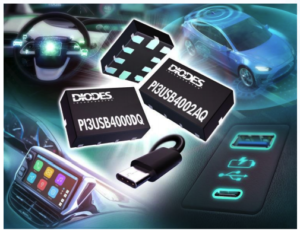 The PI3USB4000DQ/4002AQ are Diodes Incorporated’s first automotive-compliant USB 2.0, passive-signal, multi and de-multiplexer (Mux/Demux) switches. The PI3USB4000DQ is a 2:1/ 1:2 Mux/Demux and the PI3USB4002AQ is a 1:1 switch.
The PI3USB4000DQ/4002AQ are Diodes Incorporated’s first automotive-compliant USB 2.0, passive-signal, multi and de-multiplexer (Mux/Demux) switches. The PI3USB4000DQ is a 2:1/ 1:2 Mux/Demux and the PI3USB4002AQ is a 1:1 switch.
These USB 2.0 switches muxes incorporate high-voltage signal and power rail protection. Using a unique design technology, the PI3USB400xxQ has a 24-VDC withstand on the high-speed data pins, enabling them to tolerate shorts to Vbus on the USB and USB Type-C connectors.
The PI3USB4000DQ can pass USB2.0 signal with bandwidth 1GHz to maintain signal integrity and eye diagram open. The technology also provides an extremely low 35µA supply current. Both devices are available in the compact U-QFN1520-10 package.
Applications
- Smartphone
- USB-C applications
- Tablets, NB, PC
Features
- Differential bi-directional 2:1 Mux/DeMux
- Wide-input voltage range: 0 to 5.5V
- Wide bandwidth: 1GHz
- Ultra-low Con: 7pF
- Ultra-low Ron: 5Ω (typ)
- Low-propagation delay, 0.25ns typ
- Low off-isolation, -30dB@240MHz
- Low crosstalk: -35dB@240MHz,
- Low-power consumption: 35µA typical
- Wide supply voltage: 2.7 to 5.5V
- Support 1.8V Logic on the control pins
- Protection feature
- Off-protection for current leakage in power-down mode
- All I/O pins are high voltage tolerance
- C0+/C0- tolerance to 24V
- Lx+/- tolerance to 6V
- VDD tolerance to 6V
- Over-voltage protection when Vbus short to C0-/C0+ when
device is power-on and enabled - ESD Protection on (C0+/-)
- IEC61000-4-2, 10kV
Learn more and view an application diagram, here.
Filed Under: Components, News


Questions related to this article?
👉Ask and discuss on EDAboard.com and Electro-Tech-Online.com forums.
Tell Us What You Think!!
You must be logged in to post a comment.